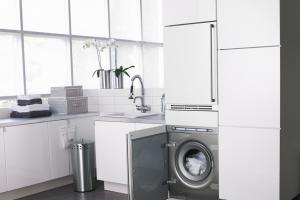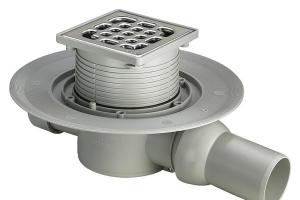How to bleed air from radiators and heating pipes
The formation of an air lock in the heating system is characterized by partial cooling of radiators or sections of a water-heated floor. Sometimes a murmur is heard in pipes and batteries, indicating the location of accumulated air. Interested in 2 questions: how to remove it from there and prevent similar troubles in the future. We propose to consider the reasons for the airing of heating appliances in private homes, and then we will show you ways to remove air bubbles from the heating network.
Where does the air in the system come from
Practice shows that it is impossible to ideally isolate a water heating network from the external environment. Air penetrates into the coolant in various ways and gradually accumulates in certain places - the upper corners of the batteries, the turns of the highways and the highest points. By the way, the latter should be equipped with automatic drain valves shown in the photo (air vents).
Varieties of automatic air vents
Air enters the heating system in the following ways:
- Along with water. It's no secret that most homeowners replenish the lack of coolant directly from the water supply. And from there comes water saturated with dissolved oxygen.
- As a result of chemical reactions. Again, not properly demineralized water reacts with the metal and aluminum alloy of the radiators, releasing oxygen.
- The pipeline network of a private house was originally designed or installed with errors - there are no slopes and loops are made, facing upwards and not equipped with automatic valves. It is difficult to expel air accumulations from such places even at the stage of refueling with coolant.
- A small fraction of oxygen penetrates through the walls of plastic pipes, despite the special layer (oxygen barrier).
- As a result of repair with dismantling of pipeline fittings and partial or complete draining of water.
- When microcracks appear in the rubber membrane.
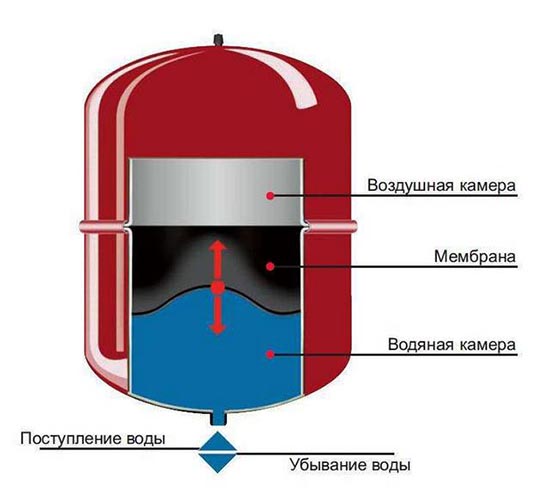 When cracks occur in the membrane, the gas mixes with water.
When cracks occur in the membrane, the gas mixes with water. Note. Water taken from wells and shallow wells is prone to chemical reactions, since it is saturated with active salts of magnesium and calcium.
Also, a situation often arises when, after a long downtime in the off-season, the pressure in a closed heating system decreases due to air ingress. Lowering it is quite simple: you just need to add a couple of liters of water. A similar effect also happens in open systems, if you stop the boiler and the circulation pump, wait a couple of days and restart the heating. When cooled, the liquid contracts, allowing air to enter the lines.
As for the centralized heating systems of apartment buildings, air enters them exclusively together with the coolant or at the time the network is filled at the beginning of the season. How to deal with it - read below.
An example from practice. From the open heating system, air congestion had to be expelled daily due to a completely clogged sump. A working pump created a vacuum in front of it and thus drew oxygen into the pipelines through the slightest leaks.
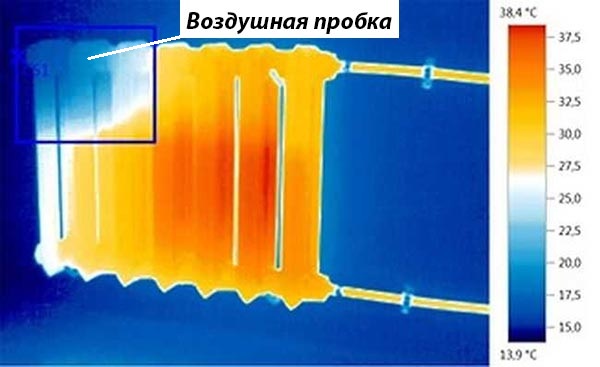 The thermogram shows the area of the heater where the air bubble usually lingers
The thermogram shows the area of the heater where the air bubble usually lingers Remove the airlock without draining the water
You probably know how to remove air from the heating system in standard ways. Having found a non-heating radiator, you need to open the Mayevsky tap in it with a screwdriver and release the air bubble. If old batteries are installed where there is no such valve, you can try removing them in other ways:
- The so-called pumping of the pipeline network is used in apartments of multi-storey buildings, provided that a tap is embedded in the radiator to discharge water. Connect a hose directed to the sewer to it, open the valve to the maximum and drain until a stream moving at high speed entrains an air lock.
- In a private house, Soviet steel batteries can be de-aired with a self-tapping screw. Wrap it at the base with FUM tape and screw it into the wall of the heater with a screwdriver (closer to the top). Then unscrew the self-tapping screw a couple of turns with a screwdriver, release the air and tighten it until it stops. In the summer, embed Mayevsky's crane in this place.
- Removal of air from the cast-iron batteries of a country house that are not equipped with air vents can be done in two ways: by completely refilling the system or by increasing pressure (up to 2 Bar) with simultaneous heating. Unscrewing the side plugs "on the go" is not recommended, then it will be difficult to pack them.
- Poor circulation and heat dissipation may be due to air accumulation in the network pump housing. Loosen the large screw at the end of the unit a couple of turns. When water drops come out from under the rubber ring, tighten it back.
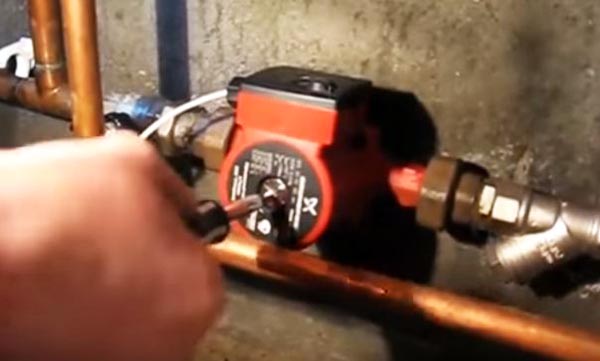
Advice. To avoid air pockets during operation, install air bleed valves on all radiators. If the thickness of the metal wall does not allow cutting 3-4 threads, weld a boss on top with a hole of the required diameter. In cast-iron accordions, the valve is embedded in a side steel plug.
The self-tapping screw focus has also been successfully applied to improperly designed up or down hinged lines (for example, to bypass doors and other building structures). How to remove the air bubble in an unfavorable place in the pipeline by tightening the self-tapping screw, see the video:
Recommendation. If you constantly bleed air from the heating system through the batteries and do not find the cause of airing, temporarily put automatic valves on the heaters until you figure out what's wrong (perhaps there is a chemical reaction with the release of oxygen).
We fill the system correctly
The easiest way is to pump water or antifreeze into pipelines connected to an open expansion tank. To do this, open all the valves (except for the drain) and, by connecting the hose to the make-up fitting, fill the lines and radiators with coolant. In this matter, it is important not to rush and allow the air to leave the system on its own through the expansion tank.
Advice. After filling, turn on the circulation pump and the boiler, and then warm up all the heating devices. Then release the remaining air from them through Mayevsky's taps. Don't forget to bleed the pump before starting as described above.
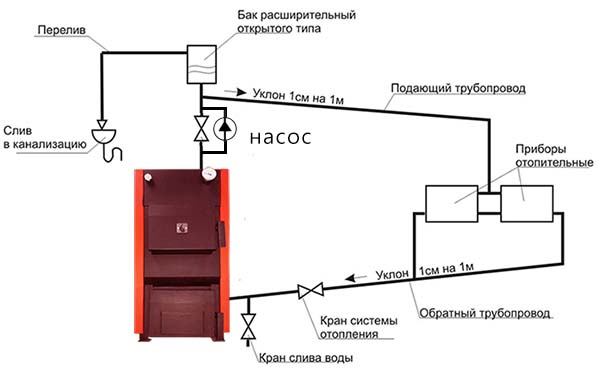
Now about how to bleed air from the batteries and pipelines of a closed heating system of a private house. The proposed technique, constantly practiced by ours, is performed in the following order:
- Open all shut-off valves of the main circuits (except for the drain).
- Close all radiator taps, except for the very last radiators at the ends of the loops, so that circulation can flow through them.
- Get an assistant to work. Its task is to be in the boiler room and maintain the pressure in the network at the level of 1 bar using a pressure test pump or through a feed branch from the water supply.
- After opening the water supply, fill the main lines, expansion tank and boiler tank. Air must be vented through the safety group valve and air vent at the highest point (if present).
- Go to the first radiator from the boiler and open both taps at the same time (slowly). Release the air through the Mayevsky valve and close the valves again. The assistant at this time does not allow the pressure to fall below 1 bar.
- Repeat the operation on all batteries, then turn on the circulation pump and start the heat generator. When the lines begin to warm up, open all the radiator valves one by one and again remove the remaining air from them.
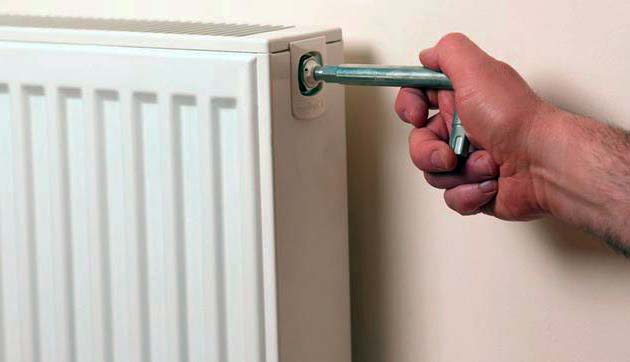
An important point. Before squeezing air locks out of the radiators, be sure to bleed the air from the circulation pump and turn it on for 5-10 minutes to bleed the pipelines.
After the heaters have completely warmed up, the pressure in the system should be within 1.3-1.6 bar. This completes the procedure. If there are warm floors in the system, then they must be filled last, using the same algorithm (on a cold one!). That is, having pumped up pressure in the main line, it is necessary to open and close the floor circuits one by one, venting air through the manifold valves, and then warming up and adjusting the coolant flow rate.
A note regarding the installation of automatic . Such a device should always be in the boiler safety group, and the second, third, and so on - only if the lines pass above the radiators. With the lower wiring in a one-story house, air accumulates in the batteries, since they are higher than the pipelines, and it is not necessary to install valves on them.
Conclusion
Releasing air from radiators is not difficult, but expelling it from the entire heating system, including underfloor heating, is a laborious task. If you make a mistake while filling the heating circuits and a stray air lock appears, it can take up to several weeks to eliminate it. So take your time and do this work thoroughly.
How to bleed air from radiators and heating pipes
4.7 94.44% 36 votes
